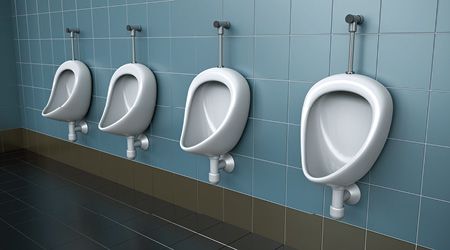
Be more productive in less time. That’s a scenario more building service contractors are facing on a routine basis. Here’s an example of addressing this problem in the restroom.
I once advised a BSC who cleaned a manufacturing plant staffed by union personnel. The union contract called for all production-area restrooms to be available 24 hours a day. As a result, union personnel were constantly complaining about restroom cleanliness. Janitors were constantly complaining about the lack of time to clean properly and were upset by the negative comments. As usual, the contractor’s supervisor was under the gun to solve the problem.
Our solution started by bringing out the BSC’s distributor representative to demonstrate a new restroom cleaning chemical. In order to demonstrate the product, the union agreed to shut down the restroom for 20 minutes.
While one person swept the floors, emptied trash and cleaned the mirrors, another used a pump-up sprayer to apply the new chemical solution onto and into the fixtures, onto the first 3 feet of the walls, and onto the partitions. The fixtures were wiped down and flushed, the walls and partitions squeegeed, the floor was mopped with clean water, dispensers were filled, and we were out of there.
Due to the success of the test using the sprayer, the union allowed a 20- to 30-minute shutdown period from that point on.
The procedures were later refined. An acid-based cleaner was used once per week inside the toilets and urinals. Since the restrooms had floor drains, the supervisor began to use foam guns attached to water hoses, which sped the process up even further. The new cleaning process had everyone’s support, because the restrooms were clean and fresh and were only closed for 20 minutes per shift.
As you have probably figured out, this happened many years ago. Thankfully, manufacturers have stepped up with equipment that takes restroom cleaning to a new level. Restroom cleaning machines offer many benefits to building service contractors.
One of the biggest benefits is the labor savings realized due to the time saved cleaning the restroom — and cleaning it right the first time. Some contractors report labor savings of 25 percent. With labor being a BSC’s biggest cost, this is a huge advantage. These machines also apply fresh cleaning solution at the correct dilution. No longer are janitors putting dirty mops back into the bucket of cleaning solution.
Another benefit I appreciate is the uniformity created by the introduction and use of the equipment throughout the BSC’s organization. Mops, buckets, wringers, etc., create many opportunities for “this is the way I’ve always done it” situations. When the machines are initially introduced and the proper training is conducted, the contractor has the opportunity to have all janitors using the same procedure.
Unlike high-pressure washing systems, this equipment uses low pressure, which makes for a safer operation and lower maintenance requirements. Some units offer a variety of options, which allow for the use of the machines in areas other than restrooms. For example, the front-mount squeegee option, available on some machines, makes for a great tool when top-scrubbing and stripping hard floors.
Mops, buckets and wringers will be around for a long time, but restroom cleaning machines allow BSCs to save labor, improve safety, do a better job of cleaning and increase customer satisfaction. Skip Seal is a trainer and consultant with more than 30 years management experience in the cleaning industry. He is a LEED Accredited Professional and a Cleaning Industry Management Standard (CIMS) ISSA Certification Expert (I.C.E.). Seal and his team offer support across the country with sales and operation analysis, new market penetration, and sales training. He can be reached at skip@seal-360.com.

 The Down and Dirty on Cleaning in Virus Season
The Down and Dirty on Cleaning in Virus Season How Surfactant Use is Expanding in Commercial Cleaning
How Surfactant Use is Expanding in Commercial Cleaning Maximize Your Margins: Learn How to Automate Pricing and Track Rebates
Maximize Your Margins: Learn How to Automate Pricing and Track Rebates